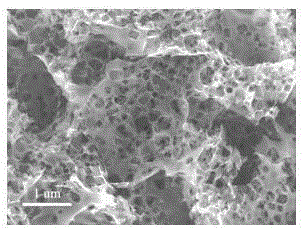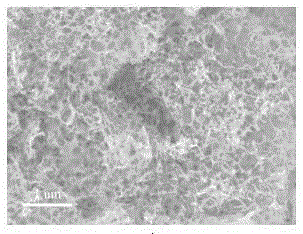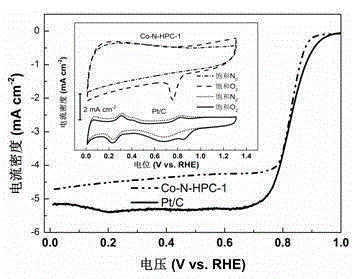Cobalt and nitrogen codoped carbon-based oxygen reduction catalyst of three-dimensional hierarchical porous structure and preparation and application thereof
A hierarchical porous catalyst technology, applied in the field of electrochemistry, can solve the problems of difficult regulation of the pore structure of the catalyst, the decrease of the number of catalyst active sites, nitrogen dissociation, volatilization, etc., and achieve excellent oxygen reduction catalytic activity and electrochemical stability, excellent Mass transfer performance, the effect of excellent mass transfer performance
- Summary
- Abstract
- Description
- Claims
- Application Information
AI Technical Summary
Problems solved by technology
Method used
Image
Examples
Embodiment 1
[0030] Preparation of Embodiment 1 Hierarchical Porous Carbon
[0031] After the yellow cattle bone is cleaned and crushed into bone powder, it is placed in a tube furnace at a flow rate of 200sccmin -1 Under the protection of high-purity argon, with 5 oC min -1 Warm up to 400 o C carbonization, stop heating after 3 hours of heat preservation, and naturally cool to room temperature to obtain a pre-carbonized product; weigh 5 g of the pre-carbonized product and activator KOH according to a mass ratio of 1:1 and grind and mix evenly, under the protection of argon at 2.5 oC min -1 Warm up to 850 oC , after heat preservation for 1h, naturally cool to room temperature to obtain activated carbonized product; then place the above activated carbonized product in 2MHNO 3 Stir and pickle in the solution for 12h, then wash with deionized water, 110 o After C was dried for 12 hours, hierarchical porous carbon was obtained, and its scanning electron microscope photo is shown in figu...
Embodiment 2
[0035] Using the preparation process of Example 1, the difference is that the amount of hierarchical porous carbon is increased to 0.4 g to prepare the catalyst Co-N-HPC-2. Depend on image 3 Nitrogen adsorption and desorption curve tests show that the catalyst has a high specific surface area, reaching 859.1m 2 g -1 , among which, micropores accounted for 28.7%, mesopores accounted for 65.8%, and macropores accounted for 5.5%. Its catalytic oxygen reduction reaction activity curve is shown in Figure 4 , compared with the Co-N-C catalyst prepared by the common carbon support VulcanXC-72, the catalyst has higher half-wave potential and kinetic current, showing excellent catalytic activity for oxygen reduction; in addition, the catalyst also has a larger Limit diffusion current, excellent mass transfer performance.
Embodiment 3
[0037] The preparation process of Example 1 is adopted, and the difference is that the heat treatment temperature of vitamin B12 and hierarchical porous carbon is reduced to 700 o C prepares the catalyst Co-N-HPC-3, which not only has excellent oxygen reduction catalytic activity, but also exhibits excellent electrochemical stability and methanol poisoning resistance, see Figure 6 , 7.
PUM
| Property | Measurement | Unit |
|---|---|---|
| Aperture | aaaaa | aaaaa |
| Mesopore diameter | aaaaa | aaaaa |
| Specific surface area | aaaaa | aaaaa |
Abstract
Description
Claims
Application Information
 Login to View More
Login to View More - Generate Ideas
- Intellectual Property
- Life Sciences
- Materials
- Tech Scout
- Unparalleled Data Quality
- Higher Quality Content
- 60% Fewer Hallucinations
Browse by: Latest US Patents, China's latest patents, Technical Efficacy Thesaurus, Application Domain, Technology Topic, Popular Technical Reports.
© 2025 PatSnap. All rights reserved.Legal|Privacy policy|Modern Slavery Act Transparency Statement|Sitemap|About US| Contact US: help@patsnap.com



